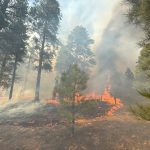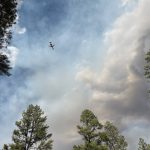
Covid cases rising, monkeypox found in Ariz.
WINDOW ROCK
Covid cases are increasing in the United States again with new Omicron subvariants spreading that are more transmissible and able to evade immunity created by vaccines and prior infection, public health experts reported this week.
While reported COVID-19 infections in the U.S. are hovering above 100,000 cases a day, the actual number is expected to be much higher because of the availability of home tests.
The good news is hospitalization and death numbers are still relatively much lower than they’ve been during past COVID surges.
The Navajo Nation reported 156 cases over the past three day weekend with 32 chapters experiencing uncontrolled spread.
“As our numbers continue to escalate, please sanitize, get your vaccine and mask up,” Vice President Myron Lizer said in a town hall on Tuesday. “Be aware of your surroundings.”
As of June 6, there have been 54,622 cases on the Navajo Nation with 1,795 deaths.
Mirroring the national trend, Navajo Epidemiologist Del Yazzie said the good news is that while cases are rising on the Nation and in surrounding states, hospitalizations remain stable with in-patient hospital capacity at 65% and ICU bed capacity at 54% for the Nation.
For the week ending June 5, average daily cases in Utah were 818 per day, with 680 per day in New Mexico and 1,863 per day in Arizona.
“There’s still a lot of Covid cases around us in bordering states,” said Yazzie.
Navajo Department of Health Director Jill Jim said the new Omicron subvariants that are spreading seem to be more transmittable so they are encouraging everyone to keep taking precautions and be really careful.
“People are still testing positive,” she said.
She said off of the reservation, it can seem like everyone is “back to normal.”
“But here on the Navajo Nation, we have not gotten to that extent,” said Jim. “There is still a major disaster declaration in effect on the Navajo Nation.”
President Jonathan Nez said at this point, it is ultimately everyone’s personal responsibility to adhere COVID-19 prevention protocols to help lessen the spread of the virus in homes and communities.
Jim also recommended that those who test positive for COVID-19 seek early treatment and consider taking the Pfizer antiviral drug being disseminated by the federal government (only as advised by their medical provider).
“Paxlovid is very effective in reducing your symptoms and preventing hospitalization,” she said.
Variant mutations
According to the CDC, over time, SARS-CoV-2, the virus that causes COVID-19, is constantly changing and accumulating mutations in its genetic code.
For the week ending June 4, the dominant Omicron variant represented 62.2% of cases in the U.S., with subvariants at 24.8%, 5.4% and 7.6% of cases.
As first reported by CNN on June 1, a preliminary study by Columbia University on May 26 found that the rapidly spreading subvariants are more than four times as likely to escape antibodies in people who’ve been vaccinated and boosted compared with older variants.
This means the subvariants are more likely to lead to breakthrough infections, even in people who’ve had Covid before.
“As the Omicron lineage has evolved over the past few months, each successive subvariant has seemingly become better and better at human transmission as well as in antibody evasion,” states the study.
“It’s a serious threat,” said Dr. David Ho, professor of microbiology and immunology at Columbia University who headed the research team.
The positive news on the variant front is that the more lethal Delta variant no longer poses a significant risk to public health in the U.S., according to the CDC.
Vaccine progress
As of June 4, about 66.7% of the total U.S. population and a comparable 67.4% of the Navajo population have been fully vaccinated with two shots.
On May 19, the CDC recommended that children ages 5 through 11 should receive a booster shot five months after their initial Pfizer-BioNTech vaccination series.
This means that everyone ages 5 years and older in the U.S. is now eligible for a booster.
The CDC also strengthened its recommendation that adults ages 50 years and older, as well as those 12 years and older who have weakened immune systems, should get a second booster at least four months after their first booster.
On June 2, White House COVID-19 Response Coordinator Dr. Ashish Jha said the FDA is currently evaluating approval of the Pfizer and Moderna vaccines for children under 5 years old and a decision is expected by mid-June.
While COVID-19 cases overall might not be as severe as they once were because of milder disease, vaccines and widely available treatments, variants that evade immunity could cause more serious infections, so some health experts are concerned about surges expected this fall and winter.
On May 17, the Biden administration announced that U.S. households are now able to order a third round of eight free at-home tests at COVIDTests.gov
As the highly transmissible subvariants of Omicron drive a rise in cases in parts of the country, using the free at-home tests can help slow the spread of the virus, they said.
Monkeypox
In other news, scientists at the CDC are tracking multiple cases of monkeypox that have been reported in several countries, including the United States.
On Tuesday, Arizona reported its first case in a man in his late thirties in Maricopa County.
According to the Maricopa County Department of Health, monkeypox is a viral illness that spreads through skin-to-skin contact.
After infection, there is an incubation period that lasts on average seven to 14 days.
Initial symptoms can include fever, muscle aches, headache, swollen lymph nodes, chills and exhaustion. Soon thereafter, a rash appears and lesions typically begin to develop before scabbing over and resolving over a period of two to three weeks.
The CDC stated that while it’s not clear exactly how people are exposed to monkeypox, early data suggest that gay, bisexual, and other men who have sex with men make up a high number of cases.
However, anyone who has been in close contact with someone who has monkeypox is at risk, they said.
“It is important to remember that monkeypox remains a rare disease here in the U.S. and Maricopa County,” said Dr. Rebecca Sunenshine, MCDPH medical director for disease control.
As a public service, the Navajo Times is making all coverage of the coronavirus pandemic fully available on its website. Please support the Times by subscribing.
How to protect yourself and others.
Why masks work. Which masks are best.
Resources for coronavirus assistance








 Highway 264,
Highway 264, I-40, WB @ Winslow
I-40, WB @ Winslow